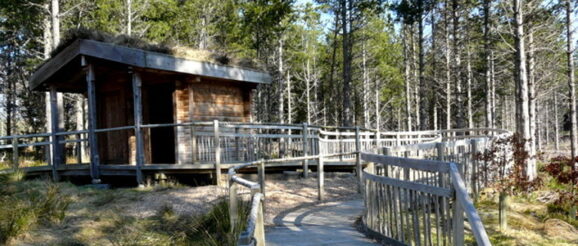From Smart Innovation to Wise Design. The World Population Recently Passed 8 Billion. We Have No Plan to Deal with All that Shit – resilience

Human infrastructures now outweigh all living mass on Earth, which means that we are rapidly transforming planetary life into dead matter.
Our current predicament demands an alternative design paradigm that envisions its infrastructures as if we were 8 billion humans living in an overstressed finite planet—because we are. The challenge is to design human settlements and food systems able to nourish all existing people and to deal with their proliferating waste, while enhancing the ecological functions that make our planet habitable.
Consider for a moment the intellectual and material contrast of a water toilet vs. a composting toilet. Both, in theory, satisfy the same human need: managing human waste.
One meets the given need by depleting the sources of nourishment upon which human survival depends (polluting fresh water and wasting energy and nutrients in the process) while the latter does it by enhancing them (transforming waste into humanure to replenish the fertility of the soil that nourishes people).
With 8 billion humans, only one of these waste management systems can be scaled up without contributing to the collapse of the planetary living systems.
Other examples include a suburban lawn versus a forest garden, an urban model centered on individual motor vehicles versus a transition town designed for walkability, and a toxic industrial monocrop versus a regenerative food system.
Most of the institutions and infrastructures that have evolved during the last few centuries of energy intensification and global economic expansion, most pronounced during the great acceleration following World War II, were designed as if energy and materials were infinitely retrievable at an ever-increasing pace. They were also designed as if a limited planet could absorb unlimited quantities of waste.
These growth-oriented and wasteful ways of designing have been heavily promoted by international financial institutions during the last decades. A growth-oriented cultural imaginary has dominated most economic and design thinking ever since.
This tendency atrophied the way techno-industrial societies understand innovative design by reducing it to clever ways to propel economic growth. As such, human communities everywhere were discouraged from sophisticating and applying non-growth oriented, life-enhancing design practices.
The result: we are currently living in a rapidly dying planet by design.
An alternative design culture more appropriate for our current predicament must clearly notice that practitioners are unwise when their designs fight against the forces of life rather than working with them, when they embrace notions of beauty that prioritize convenient, manicured, uniformed, and toxified space over healthy and biodiverse habitats, and when their projects displace and impoverish life while being dependent on massive inputs of energy that may not be available in the near future.
Mainstream, unwise design cultures—think again of large suburban lawns, industrial agriculture, or car-centric urban models—generate unmanageable waste, deepen inequality, deplete topsoil, drive extinction, disrupt ecological cycles, and ultimately decrease the chances for most humans to flourish and have a viable future.
Wise design cultures, in contrast, do the opposite by striving to simultaneously regenerate soils and cohere communities.
The Industrial Revolution imagined a dead mechanized world and designed its infrastructures accordingly. A life-affirming design culture for the 21st century needs to put life intelligence at the center and simultaneously address human wellbeing and whole systems health.
Although two hundred years of abundant fossil fuel energy has produced and globalized unwise cultures of design that are driving ecological calamity, there is a possibility—by no means guaranteed—that the inevitable and progressive global energy decline and the ongoing ecological breakdown will bring about a rapid rise of wiser design cultures, everywhere.
Soon, massive constraints will likely be imposed upon most designers by material and energy limits. As biophysical limits can no longer be ignored, increasing material constraints will force communities to design differently in order not to perish.
The good news is that recognizing limits enhances creativity. In design-thinking, there is a strategy for the ideation phase based on imposing constraints (known as the concept of enabling constraints) due to the fact that not having unlimited possibilities makes designers more focused and creative.
As modern infrastructures fail to sustain their functions, human communities everywhere may be forced to re-localize food production and find creative solutions to put energy and ecology at the center of their design practices.
These emerging alternative design cultures will need to deal not only with the toxic infrastructures left behind by the massive techno-industrial design failure but also with its psychosocial consequences: corrosive inequality, declining mental health, and political polarization, just to name a few.
To address these issues appropriately, justice should always be at the center of any wise emerging design thinking.
As permaculture practitioners understand quite well, one of the primary design problems is uneven distribution, as it creates an imbalance that tends to compromise the health of the whole system.
Wise design is therefore ecologically regenerative and socially just.
Contemporary societies are trapped in socially and ecologically depleting infrastructures developed by technologically “smart”, but deeply unwise, cultures of design.
Unwise because they were mostly energy blind, unconcerned of biophysical limits, inattentive to ecological and cultural diversity, and untrained in systems thinking.
Most infrastructures put into place by these cultures of design are de-futuring, as they deplete the social, ecological, and energy systems upon which they completely depend.
If wise cultures of design were to permeate institutional priorities at all levels, communities would design differently and, radically different, life-enhancing cultures could emerge.
Our current predicament calls for transitional design approaches able to displace the all-pervasive “smart” design cultures that are killing life on Earth.
Existing “techno-smart” cultures of design are not wise enough to properly manage the waste generated by 8 billion humans, so we better transition to wiser cultures of design able to compost—literally and figuratively—all that shit.
Teaser photo credit: “Eco-loos” at Abriachan Community Forest. A green-roof toilet building constructed from local materials. By sylvia duckworth, CC BY-SA 2.0, https://commons.wikimedia.org/w/index.php?curid=13950029.
